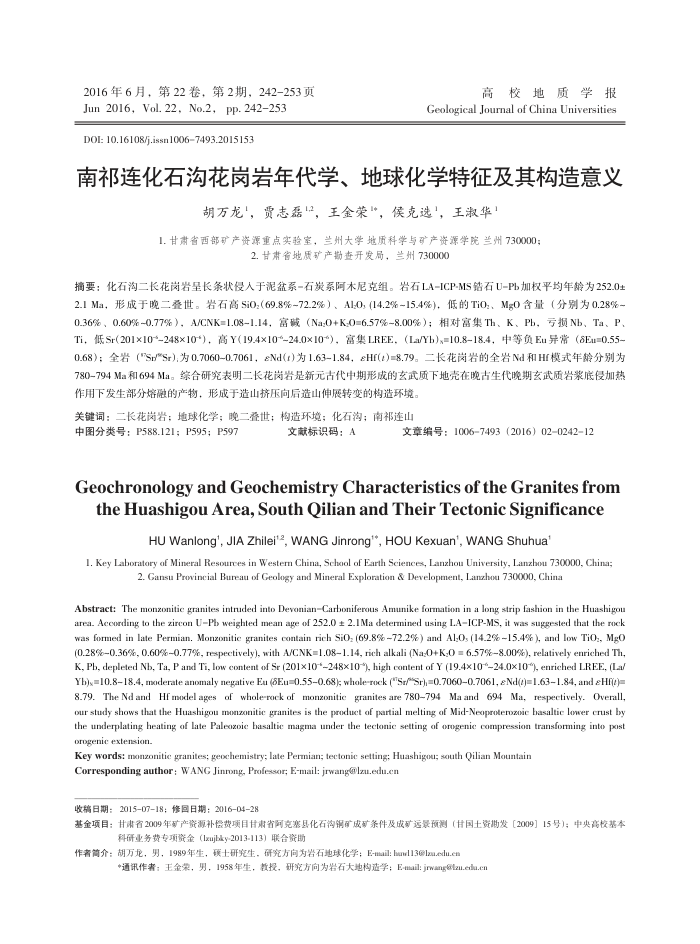南祁连化石沟花岗岩年代学、地球化学特征及其构造意义
内容简介
 2016年6月,第22卷,第2期,242-253页
2016年6月,第22卷,第2期,242-253页Jun 2016,Vol.22,No.2,pp.242253 DOI: 10.16108/j.issn10067493.2015153
交地质学报
高校
Geological Journal of China Universities
南祁连化石沟花岗岩年代学、地球化学特征及其构造意义
胡万龙,贾志磊2,王金荣,侯克选",王淑华
1.甘肃省西部矿产资源重点实验室,兰州大学地质科学与矿产资源学院兰州730000:
2.甘肃省地质矿产勘查开发局,兰州730000
摘要:化石沟二长花岗岩呈长条状侵人于泥盆系-石炭系阿本尼克组。岩石LA-ICP-MS锆石U-Pb加权平均年龄为252.0± 2.1Ma,形成于晚二叠世。岩石高Si0,(69.8%-72.2%)、Al,0,(14.2%~15.4%),低的Ti0:、Mg0含量(分别为0.28%~ 0.36%,0.60%0.77%),A/CNK=1.08-1.14,富碱(Na:0+K;0=6.57%~8.00%);相对富集Th、K、Pb,亏损Nb、Ta、P、 Ti,低Sr(201×10~248x10*),高Y(19.4×10*24.0×10*),富集LREE,(La/Yb)x=10.818.4,中等负Eu异常(8Eu=0.55 0.68);全岩("SrSr)为0.7060~0.7061,εNd(r)为1.63-1.84,εHf(s)=8.79。二长花岗岩的全岩Nd和Hf模式年龄分别为 780-794Ma和694Ma。综合研究表明二长花岗岩是新元古代中期形成的玄武质下地壳在晚古生代晚期玄武质岩浆底侵加热
作用下发生部分熔融的产物,形成于造山挤压向后造山伸展转变的构造环境。关键词:二长花岗岩;地球化学;晚二叠世;构造环境;化石沟;南祁连山
中图分类号:P588.121;P595;P597
文献标识码:A
文章编号:10067493(2016)02024212
GeochronologyandGeochemistryCharacteristicsoftheGranitesfrom
theHuashigouAreaSouthQilianandTheirTectonicSignificance
HU Wanlong', JIA Zhilei'2, WANG Jinrong', HOU Kexuan', WANG Shuhua
1. Key Laboratory of Mineral Resources in Westerm China, School of Earth Sciences, Lanzhou University, Lanzhou 730000, China:
2. Gansu Prorincial Bureau of Geology and Mineral Exploration & Development, Lanzhou 730000, China
Abstract: The monzonitic granites intruded into DevonianCarboniferous Amunike formation in a long strip fashion in the Huashigou area. According to the zireon UPb weighted mean age of 252.0 ± 2.1Ma determined using LAICP-MS, it was suggested that the rock was formed in late Permian. Monzonitic granites contain rich SiO, (69.8% 72.2%) and Al:Os (14.2% 15.4% ), and low TiO:, MgO(0.28%~0.36%, 0.60%~0.77%, respectively), with A/CNK=1.08~1.14, rieh alkali (Na:0+K:O = 6.57%~8.00%), relatively enriehed Th/) oa (,0x0t0x6) jo ao (01x8t,0[0 as jo a o p d qN paap “d “ Yb)x=10.818.4, moderate anomaly negative Eu (Eu=0.550.68); whole-rock (°Sr/°Sr)=0.70600.7061, eNd()=1.631.84, and eHf(t) 8.79. The Nd and Hf model ages of whole-rock of monzonitic granites are 780794 Ma and 694 Ma, respectively. Overall, our study shows that the Huashigou monzonitic granites is the product of partial melting of Mid-Neoproterozoic basaltic lower crust by the underplating heating of late Paleozoic basaltic magma under the tectonic setting of orogenic compression transfoming into post orogenic extension.
Key words: monzonitic granites; geochemistry; late Permian; tectonic setting; Huashigou; south Qilian Mountain
Corresponding author: WANG Jinrong., Professor; E-mail: jrwang@lzu.edu.cen 收稿日期:201507-18;修回日期:2016-0428
【600)600
科研业务费专项资金(xujlbky-2013-113)联合资助
作者筒介:胡万龙,男,1989年生,碳土研究生,研究方向为石地球化学;E-mail:lhuwl13@lza.edu.cn
*通讯作者:王金荣,男,1958年生,教授,研究方向为岩石大地构造学;E-mail:jrwangeizu.eda.cn